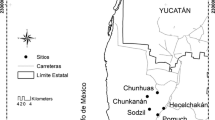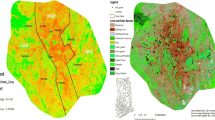Abstract
Trees in urban areas are important sources of ecosystem services and benefits. In most towns the bulk of urban biodiversity, and trees specifically, are found in homestead gardens. But there is only limited understanding of the tree holdings in such gardens, and how they vary within and between towns, especially for developing countries where rapid urbanisation and high poverty influence the use of and reliance on land and local resources. We report on the nature of tree holdings in private gardens of poorer suburbs in three medium-sized towns along a gradient of decreasing mean annual rainfall in northern South Africa. A total of 3 217 trees were enumerated across 450 randomly selected homesteads. Most (90 %) households had at least one tree on their homestead, with an average of 7.7 ± 6.1 trees. Most householders had planted the trees themselves. The density of trees declined along the moisture gradient. Within towns, tree density was positively related to garden size, which in turn was related to relative affluence and age of the suburb. Newer and poorer suburbs had the fewest trees per household. Sixty-two tree species were recorded, which were dominated by alien species, especially fruit trees. There was no relationship between the moisture gradient and tree species richness per household, but within towns there was a difference between suburbs, being lowest in the newest suburbs. Numbers of trees and species per household was positively related to age of the household head.



Similar content being viewed by others
References
Adekunle MF, Agbaje BM (2012) Public willingness to pay for ecosystem service functions of a peri-urban forest near Abeokuta, Ogun State, Nigeria. J Dev Agric Econ 4:45–50
Ahrends A, Burgess ND, Milledge SAH, Bulling MT, Fisher B, Smart JCR, Clarke GP, Mhoro BE, Lewis SL (2010) Predictable waves of sequential forest degradation and biodiversity loss spreading from an African city. Proc Natl Acad Sci U S A 107(33):14556–14561
Alam MS, Masum KM (2005) Status of homestead biodiversity in the offshore island of Bangladesh. Res J Agric Biol Sci 1:246–253
Alvey AA (2006) Promoting and preserving biodiversity in the urban forest. Urban For Urban Green 5:195–201
Bansal M, Saini RP, Khatod DK (2013) Development of cooking sector in rural areas in India: a review. Renew Sust Energ Rev 17:44–53
Barbosa O, Tratalos JA, Armstrong PR, Davies RG, Fuller RA, Johnson P (2007) Who benefits from access to green space? A case study from Sheffield. UK. Land Urban Plan 83:187–195
Bela Bela local municipality IDP (2010) Integrated development plan 2010/2011. Bela Bela local municipality. South Africa. 1–185
Bentsen P, Lindholst AC, Konijnendijk CC (2010) Reviewing eight years of urban forestry and urban greening: taking stock, looking ahead. Urb For Urb Green 9:273–380
Bernholt H, Kehlenbeck KK, Gebauer J, Buerkert A (2009) Plant species richness and diversity in urban and peri-urban gardens of Niamey, Niger. Agrofor Syst 77:159–179
Bigirimana J, Bogaert J, De Canniere C, Bigendako M-J, Parmentier I (2012) Domestic garden plant diversity in Bujumbura, Burundi: role of the socio-economical status of the neighbourhood and alien species invasion risk. Land Urban Plan 107:118–126
Chibende C (2009) To investigate the effects of selling government houses on the conservation of urban forests, Special project report. The Copperbelt University, Kitwe
Cilliers SS, Muller N, Drewes E (2004) Overview on urban nature conservation: situation in the western-grassland biome of South Africa. Urb For Urban Green 3:49–62
Davenport N, Gambiza J, Shackleton CM (2011) Use and user of municipal commonage around three small towns in the Eastern Cape, South Africa. J Environ Mgmt 92:1149–1460
DeFries R, Pandey D (2010) Urbanization, the energy ladder and forest transitions in India’s emerging economy. Land Use Policy 27:130–138
Fuwape JA, Onyekwelu JC (2011) Urban forest development in West Africa: benefits and challenges. J Biodivers Ecol Sci 1:77–94
Gangopadhyay K, Balooni K (2012) Technological infusion and the change in private, urban green spaces. Urban For Urban Green 11:205–210
Gonzáles-Garcia A, Gómez Sal A (2008) Private urban greenspaces or “patios” as a key element in the urban ecology of tropical central America. Hum Ecol 36:291–300
Greater Tzaneen Local Municipality IDP (2011) Integrated development plan 2011/2012. Greater Tzaneen Local Municipality. South Africa. 1–366
Grimm NB, Faeth SH, Golubiewski NE, Redman CL, Wu J, Bai X, Briggs JM (2008) Global change and the ecology of cities. Sci 319:756–760
Horst A (2006) Rehabilitation of urban forests in Addis Ababa. J Dry 1:108–117
Hunter M, Posel D (2012) Here to work: the socioeconomic characteristics of informal dwellers in post-apartheid South Africa. Environ Urban 24:285–304
Iverson LR, Cook EA (2000) Urban forest cover of the Chicago region and its relation to household density and income. Urban Ecosys 4:105–124
Kaoma H, Shackleton CM (2014) Collection and use of urban tree products by households in poorer residential areas of three South African towns. Urban For. Urban Green. doi:10.1016/j.ufug.2014.02.002
Kuchelmeister G (1999) Urbanisation in developing countries-time for action for national forest programmes and international development cooperation for the urban millennium. Forest policy research forum: the role of national forest programmes to ensure sustainable forest management. Joensuu, Finland, pp 1–17
Kuchelmeister G (2001) Urban forestry. CTA, Wageningen, pp 1–7
Long AJ, Nair PKR (1999) Trees outside forests: agro, community and urban forestry. New For 17:145–174
Lubbe CS, Siebert SJ, Cilliers SS (2010) Political legacy of South Africa affects the plant diversity patterns of urban domestic gardens along a socio-economic gradient. Sci Res Essays 5:2900–2910
McConnachie MM, Shackleton CM (2010) Public green space inequality in small towns in South Africa. Habitat Intn 34:244–248
Montgomery MR (2008) The urban transformation of the developing world. Sci 319:761–764
Mosha AC (2012) Low income access to urban housing and land in Botswana. Urban Forum (in press)
Mucina L, Rutherford CR (eds) (2006) The vegetation of South Africa, Lesotho and Swaziland. Strelitzia 19. South African national Biodiversity Institute, Pretoria
Ndaeyo NU (2007) Assessing the contributions of homestead farming to food security in a developing economy: a case study of south-eastern Nigeria. J Agric Soc Sci 1:11–16
Nel JL, Richardson DM, Rouget M, Mgidi TN, Mdzeke N, le Maitre DC, van Wilgen BW, Schonegevel L, Henderson L, Neser S (2004) A proposed classification of invasive alien plant species in South Africa: towards prioritising species and areas for management action. S Afr J Sci 100:53–64
Neuman WL (2003) Social research methods: qualitative and quantitative approaches, 4th edn. Mass: Allyn and Bacon, Boston, pp 1–600
Ngaka Modiri Molema District Municipality IDP (2007) Integrated development plan 2007–2011. Ngaka Modiri Molema District Municipality. 1–137
Nkambwe M, Sekhwela MB (2006) Utilization characteristics and Importance of woody biomass resources on the rural–urban fringe in Botswana. Environ Mgmt 37:281–296
Paumgarten F, Shackleton CM, Cocks M (2005) Growing trees in home-gardens by rural households in the Eastern Cape and Limpopo provinces, South Africa. Intn J Sust Dev World Ecol 12:365–381
Shackleton CM (2012) Is there no urban forestry or greening in the developing world? Sci Res Essays 7(40):3329–3335
Shackleton CM, Paumgarten F, Cocks ML (2008) Household attributes promote diversity of tree holdings in rural areas, South Africa. Agrofor Sys 72:221–230
Shackleton CM, Hebinck P, Kaoma H, Chishaleshale M, Chinyimba A, Shackleton SE, Gambiza J, Gumbo D (2014) Low-cost housing developments in South Africa miss the opportunities for household level urban greening. Land Pol 36:500–599
Singh VS, Pandey DN, Chaudhry P (2010) Urban forests and green spaces: lessons for Jaipur. RSPCB occasion paper 1/2010. Rajasthan, India. Rajasthan State Pollution Control Board (RSPCB), India, pp 6–17
Smith RM, Thompson K, Hodgson JG, Warren PH, Gaston KJ (2006) Urban domestic gardens (IX): composition and richness of the vascular plant flora, and implications for native biodiversity. Biol Constr 129:312–322
Stats SA (2008) Community survey 2007 basic results: municipalities. Statistics South Africa, Pretoria, pp 1–28
Stats SA (2001) Concepts and definitions. Report no. 03.02.26. Statistics South Africa, Pretoria, pp 1–19
Termote C, Everaert G, Meyi MB, Djailo BD, Van Damme P (2012) Wild edible plant markets in Kisangani, democratic republic of Congo. Human Ecol 40:269–285
Tratalos J, Fuller RA, Warren PH, Davies RG, Gaston KJ (2007) Urban form, biodiversity potential and ecosystem services. Land Urban Plan 83:308–317
Uddin MJ, Hasan MK (2001) Economics of homestead agroforestry in Char areas at Noakhali District. Proceedings of National Workshop on Agrofestry Research. Bangladesh. 37–43
Venn SJ, Niemela JK (2004) Ecology in a multidisciplinary study of urban green space: the urge project. Boreal Environ Res 9:479–489
Wilkinson P (1998) Housing policy in South Africa. Habitat Intn 22:215–229
Zhang Y, Tarrant MA, Green GT (2008) The importance of differentiating urban and rural phenomena in examining the unequal distribution of locally desirable land. J Environ Mgmt 88:1314–1319
Zipperer WC, Foresman TW, Walker SP, Daniel CT (2012) Ecological consequences of fragmentation and deforestation in an urban landscape: a case study. Urban Ecosyst 15:533–544
Acknowledgments
HK and the field work were funded by SANPAD (project 10/58), for which we are grateful. We are also indebted to Tony Dold at the Selmar Schonland Herbarium (Grahamstown) for his help in identifying some of the tree species.
Author information
Authors and Affiliations
Corresponding author
Rights and permissions
About this article
Cite this article
Kaoma, H., Shackleton, C.M. Homestead greening is widespread amongst the urban poor in three medium-sized South African towns. Urban Ecosyst 17, 1191–1207 (2014). https://doi.org/10.1007/s11252-014-0362-3
Published:
Issue Date:
DOI: https://doi.org/10.1007/s11252-014-0362-3




